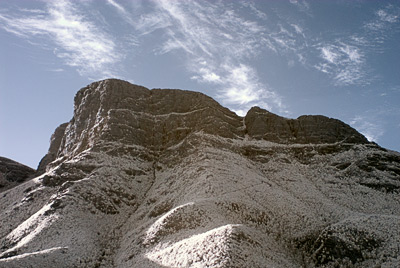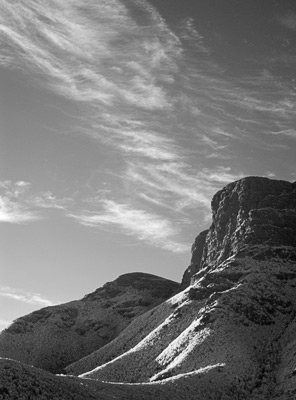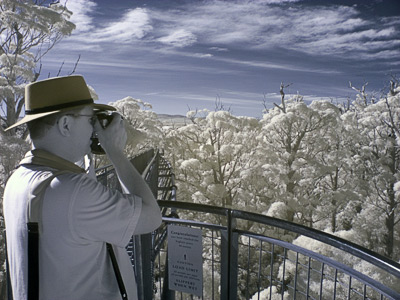|
Subscribe to this site's News feed via RSS:

Our partners:

|
Choosing IR Cameras
David Burren
October 2006
The Digital IR Choices article has moved to a
new location.
The
False Colour Photoshop Action is
described on the same page.
Infrared (IR) photography has a number of applications, and a variety
of cameras have features that make them attractive choices for conversion.
Unfortunately most of the on-line camera reviews (for example at
DPReview)
are not written with these uses in mind, and a camera that reviews
well may end up with serious shortcomings.

|
Bluff Knoll, WA
Canon Pro1/R72
|
As we come across different models I intend to update this article with notes about each model.
These notes are with regard to "converted" cameras, where the original internal IR-blocking filter has been
removed and replaced either with clear glass (combined with external filters) or with an internal IR-pass
filter.
For more information on this, see our Digital IR Choices page.
Details of the conversions we offer are also available.
One of the fundamental features important in an infrared camera is
the ability to use RAW files.
Not only does this give you the flexibility to adjust the white
balance when processing the photos, but it also provides more than
8 bits per pixel (typically 12: 4096 shades per pixel) which allows
for cleaner images during post-processing.
RAW support is an initial criteria for me in choosing the following cameras.
Cameras covered in this article are:
Scenarios
Different camera uses can take advantage of different features, so it's
probably useful to set the scene and outline some of those uses.
|
Walk-around camera
| |
This is the "general-purpose" category, where the photographer might
be using the camera handheld, on a tripod, or whatever.
Landscape photography, weddings, etc all fall into this category.
Useful features include:
-
Electronic viewfinder (not LCD)
With infrared imagery it's very useful to see the IR image instead of the visible-light image
shown through an optical viewfinder.
Being able to put your eye up to the viewfinder has advantages of visibility and camera stability.
While eye-level electronic viewfinders do show less detail than the optical viewfinder of an SLR or rangefinder,
the benefit of seeing the infrared image outweighs those drawbacks.
-
"Shooting priority". Cameras with this will switch to record mode when the shutter button is half-pressed,
no matter what the camera was doing beforehand (e.g. reviewing photos or in a menu).
-
Availability of a tripod quick-release system is also important to many photographers.
| |
Unattended time-lapse camera
| |
Consider a camera recording vegetation conditions in a fixed location.
Useful features:
-
External power
-
The ability to wake up the camera, take a photo with known settings, and power off again.
Either an inbuilt intervalometer, or an interface to allow control by an external computer.
This might be as simple as an electrical interface to switch the camera on after it's been off for hours,
and another to take the shot.
| |
Aerial mapping
| |
Infrared imaging has a long history of use in aerial mapping.
Sometimes this is with a camera in a housing under a plane wing, sometimes in the fuselage,
and sometimes suspended from a kite.
Useful features:
-
Remote control - an operator (in the plane or at the bottom of the kite string) needs to be able to trigger the camera.
-
In a plane the ability to download images to a computer "on-the-fly" may be useful.
-
Weight: important for a kite.
|
Of course there are more uses that don't fit these categories: this is not meant to be an exhaustive list!
Cameras

|
Bluff Knoll, WA
Canon Pro1/R72
|
Not all cameras are well-suited to the above applications.
Hopefully this list will give you an overview.
Canon EOS DSLRs
A range of models can be used for IR work.
Once converted, the behaviour of each camera's sensor is fairly similar in terms of IR image quality,
and the differences between the models are closely related to the differences in terms of "normal" use
(e.g. size, weight, speed, etc).
| EOS model | comments
|
|---|
|
5D/30D (12, 8 Mp)
|
R/G/B histograms
| |
1Ds/1D (11, 4 Mp)
|
| |
20D/350D/10D/300D/D60/D30 (8, 6, 3 Mp)
|
| |
400D (10 Mp)
|
R/G/B histograms
Dust-removal technology
|
They all have some common issues:
Pros:
-
With relatively large sensors the images are usually quite clean and noise-free.
-
They're all "shooting-priority" cameras.
-
A simple but effective 3-wire remote control interface is provided.
-
A wide choice of mounting plates (including L-plates from RRS and Kirk) are available.
-
A wide range of lenses is available, although some produce "IR hot spots".
Cons:
-
The camera's metering is geared to visible light, and manual metering must be used for reliable
IR exposures.
This can have a negative impact on the camera's flexibility in unattended and aerial-mapping scenarios.
-
It also affects flash metering: flash exposure needs to be handled manually (no TTL metering).
-
External filters can be used, but they will obscure the optical viewfinder so their use in
hand-held situations is limited.
Nikon DSLRs
Various Nikon DSLRs can also be used, with similar issues to the EOS models.
As at December 2006 we have stopped accepting conversion requests for D70 & D70s cameras.
This may change in 2007.
Fujifilm S3 Pro UVIR
In August 2006 Fujifilm USA announced a variant of their S3 Pro DSLR: the S3 Pro UVIR.
This camera is an S3 Pro which has been converted with a clear filter:
it requires the use of appropriate filters mounted on the lens.
Because the S3 Pro is an SLR, this means that the filters will also affect the
light reaching the viewfinder and AF system, and this can severely restrict
the camera's use as a handheld unit.
However, the S3 Pro has a trick up its sleeve: it has a preview mode where the
mirror is locked up for 30 seconds and the LCD will display the image from the
main sensor in B&W.
Using this the photographer can fine-tune the composition and focus, and then
take the photo when out of preview mode (hopefully without moving the camera in
the meantime).
Note that the S3 Pro UVIR appears to be a product of Fujifilm USA: they source
S3 Pro cameras (a discontinued model) and perform the equivalent of our CLR
conversion.
It's unclear how support for the product outside North America will turn out.
My understanding is that no adjustment of the camera's focus is done during the
conversion (once an IR filter is mounted on the lens the camera's AF and
viewfinder are useless anyway, and the preview mode [and/or test shots] must be
used to get the focus right).
Like any other DSLR with a "CLR" conversion I regard this camera as being more
suited to studio use (despite the preview function) than field use.

|
Valley of the Giants, WA
Canon Pro1/R72
|
Canon PowerShot Pro1
Introduced in 2004, this 8-megapixel camera has not been replaced,
although it has been discontinued (in 2006?) so any purchases will
either be from remaining new stock or secondhand units.
Pros:
-
Has a good eye-level electronic viewfinder,
and the rear LCD can be swivelled out for angled shooting.
-
The lens has a large zoom range: from 28mm to 200mm (35mm equivalent).
-
A "shooting-priority" camera.
-
The flash hot-shoe can be used with Canon's EX flashes for E-TTL flash metering, as can the internal flash.
-
The shot-to-shot performance is quite good.
With a delay of about a second after each shot, several RAW images
can be taken in a row without the camera slowing down.
As long as its internal buffer doesn't fill up, it saves the files
silently in the background.
-
Can capture 640x480 B&W movies in AVI format.
-
An internal 3-stop ND filter (enabled through the menu) can be used if you're trying to duplicate some of the
"features" of non-modified cameras.
-
An Arca-Swiss-compatible L-plate is available for the Pro1 (from Really Right Stuff).
Cons:
-
With "false-colour" filters such as the R72, the lens will in some
situations produce an "IR hot spot" in the centre of the image.
With darker filters (such as the Wratten 87) this issue disappears.
-
Image noise can be an issue at higher ISOs: software such as Noise Ninja is very useful.
-
Mounting system for external 58mm filters is ungainly: it requires removing the lens hood and finding an alternative.
Further discussion on the use of the Pro1 for IR can be found in
a separate article.
Olympus C-8080WZ
This 8-megapixel camera was introduced an 2004, and on reading most on-line reviews seems like a very nice camera.
My testing turned up a few issues though...
Pros:
-
Has a preview histogram so you can see it before you take a photo.
-
Has an eye-level electronic viewfinder, albeit with some restrictions (see below).
-
Lens has a 58mm thread for filters.
-
The flash hot-shoe can be used with Olympus external flashes with metering, as can the internal flash.
-
Power-on zoom position is programmable.
Very nice for unattended operation.
Cons:
-
Is not a "shooting-priority" camera: the mode dial must be switched to "play" mode to review images.
-
The lens produces a strong "IR hot spot" in the centre of the image with all IR filters I've tested.
-
Image noise can be an issue at higher ISOs: software such as Noise Ninja is very useful.
-
Enormous RAW files (20 Mbytes, even though it's an 8Mp camera and when re-saved as DNG files they're only 10 Mbytes).
-
The eye-level viewfinder is not implemented as well as the Canon Pro1's.
For example when you press a button to invoke the on-screen menus,
the camera switches everything over to the rear LCD until the menu goes away.
On the Pro1 the menu appears on whichever screen is active at the
time, and this makes a difference when you're working in bright sunlight.
-
The preview histogram goes away when you half-press the shutter button in preparation for a shot.
-
Then when you've taken the shot, the camera freezes for over 13s while
it saves the RAW file (but at least it shows you the histogram during this time).
Even with fast cards such as a SanDisk Extreme III the camera's still this slow.
Thirteen seconds is an eternity when you're waiting behind the
camera, even with the "slower" fields of photography such as landscape
work.
-
The tripod mount is very ungainly.
Canon PowerShot S60/S70
These small cameras only differ in their sensor: the S60 is 5 megapixels, the S70 has 7 Mp.
Unfortunately they've been discontinued, and the later S80 doesn't have RAW support.
Pros:
-
Small and pocketable cameras.
-
Quite clean images with low noise.
-
Very good lens: 28-100mm equivalent (wider than many compacts).
-
"Shooting-priority" cameras.
-
The internal flash metering works fine in IR (no hot-shoe is provided).
-
Remote control can be achieved with an LED over the camera's remote sensor.
Cons:
-
No eye-level electronic viewfinder, and rear LCD is fixed in position.
-
No facility is available for attaching external filters.
Canon PowerShot G6
Another discontinued camera, in 2006 it's still available from some suppliers.
Pros:
-
LCD viewfinder can be flipped out and rotated.
-
A "shooting-priority" camera.
-
Adapters for external 52mm or 58mm filters are available.
-
Quite clean images with low noise.
-
The G6's flash hot-shoe can be used with Canon's EX flashes for E-TTL flash metering, as can the internal flash.
-
Remote control can be achieved with an LED over the camera's remote sensor, or the camera
can be modified with a hard-wired interface to allow unattended power-up.
-
Can capture 640x480 B&W movies in AVI format.
-
An internal 3-stop ND filter (enabled through the menu) can be used if you're trying to duplicate some of the
"features" of non-modified cameras.
Cons:
-
No eye-level electronic viewfinder.
-
Lens retracts into the body on power-off, but the lens cap does not attach robustly and this
affects the "pocketability" of the camera.
The filter adapter does improve the situation, although at the cost of a little bulk.
-
Lens doesn't zoom very wide (35-140mm equivalent).
Sony CyberShot DSC-R1
Pros:
-
Large "APS-sized" 10-megapixel sensor promises clear images.
-
Eye-level electronic viewfinder, and flip-up/twist LCD
Cons:
-
The R1 is reported to show a strong IR hot spot at mid-to-small apertures.
-
No custom Arca-Swiss plates are yet available for the R1.
We plan to add more notes on the R1 later in 2006.
Canon PowerShot S30/S40/S45/S50
These precursors to the S60/S70 range from 3 to 5 megapixels, all with RAW support.
They're small and "pocketable", but their lenses only zoom from 35-105mm.
The S30 & S40 do not auto-rotate images taken in "portrait" orientation.
If you use Arca-Swiss quick-release mounts on your tripod/etc and other cameras,
the Wimberley
P-5 plate fits these cameras very well (although it does cover the
battery/CF door, I've generally not managed to empty a battery or fill a CF
card in less than a day).
Canon PowerShot G3/G5
These precursors to the G6 only differ in their number of pixels: 4 or 5 megapixels.
Canon PowerShot G1/G2
These precursors to the G3 have 3 or 4 megapixels, and are fairly primitive.
They do not have "shooting-priority", do not auto-rotate images,
and their histogram support is basic or non-existant.
Hopefully this overview of camera models is useful to you!
We will add more information over time.
Remember to check our Digital IR Choices page for further information about digital IR photography.
|




![]()